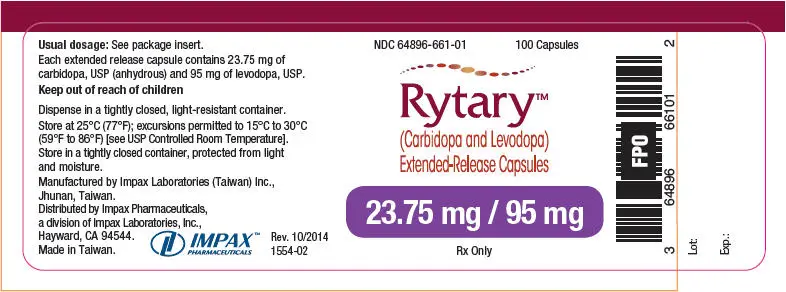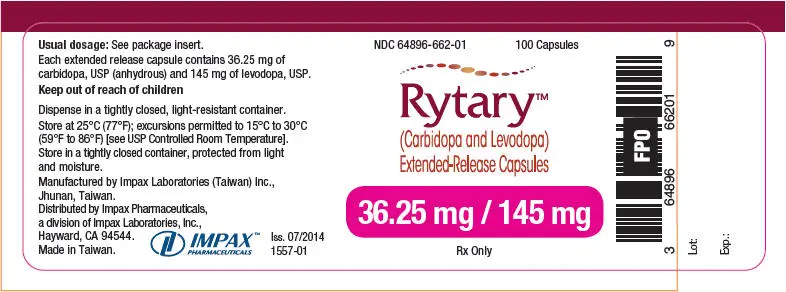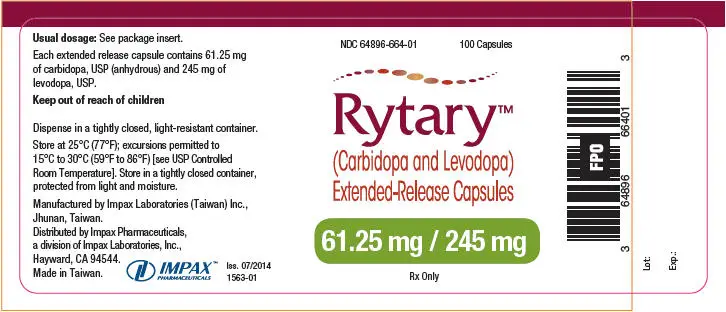Drug Detail:Rytary (Carbidopa and levodopa [ kar-bi-doe-pa-and-lee-voe-doe-pa ])
Drug Class: Dopaminergic antiparkinsonism agents
Highlights of Prescribing Information
RYTARY (carbidopa and levodopa) extended-release capsules, for oral use
Initial U.S. Approval: 1975
Indications and Usage for Rytary
RYTARY is a combination of carbidopa (an aromatic amino acid decarboxylation inhibitor) and levodopa (an aromatic amino acid) indicated for the treatment of Parkinson's disease, post-encephalitic parkinsonism, and parkinsonism that may follow carbon monoxide intoxication or manganese intoxication (1)
Rytary Dosage and Administration
- Levodopa-naïve patients: Starting dose is 23.75 mg / 95 mg three times daily; may increase to 36.25 mg / 145 mg three times daily on the fourth day of treatment (2.1)
- See Table 1 for instructions for converting patients taking immediate- release carbidopa-levodopa to RYTARY; dosages of RYTARY are not interchangeable with other carbidopa-levodopa products (2.2)
- The maximum recommended daily dose of RYTARY is 612.5 mg / 2450 mg (2.1, 2.2)
- RYTARY may be taken with or without food; do not chew, divide or crush (2.4, 12.3)
Dosage Forms and Strengths
Extended-release capsules: Carbidopa and levodopa 23.75 mg / 95 mg, 36.25 mg / 145 mg, 48.75 mg / 195 mg, 61.25 mg / 245 mg (3)
Contraindications
Nonselective MAO inhibitors (4)
Warnings and Precautions
- May cause falling asleep during activities of daily living (5.1)
- Avoid sudden discontinuation or rapid dose reduction to reduce the risk of withdrawal-emergent hyperpyrexia and confusion (5.2)
- Cardiovascular Events: Monitor patients with a history of cardiovascular disease (5.3)
- Hallucinations/Psychosis may occur (5.4)
- Impulse Control Disorders: Consider dose reduction or stopping RYTARY if occurs (5.5)
- May cause or exacerbate dyskinesia: Consider dose reduction (5.6)
Adverse Reactions/Side Effects
- Early Parkinson's disease: Most common adverse reactions (incidence ≥ 5 % and greater than placebo) are nausea, dizziness, headache, insomnia, abnormal dreams, dry mouth, dyskinesia, anxiety, constipation, vomiting, and orthostatic hypotension (6.1)
- Advanced Parkinson's disease: Most common adverse reactions (incidence ≥ 5 % and greater than oral immediate-release carbidopa-levodopa) are nausea and headache (6.1)
To report SUSPECTED ADVERSE REACTIONS, contact Impax Laboratories at 1-877-99-IMPAX or FDA at 1-800-FDA-1088 or www.fda.gov/medwatch
Drug Interactions
Iron salts and dopamine D2 antagonists including metoclopramide: May reduce the effectiveness of RYTARY (7.2, 7.3)
Use In Specific Populations
Pregnancy: Based on animal data, may cause fetal harm (8.1)
See 17 for PATIENT COUNSELING INFORMATION.
Revised: 1/2015
Related/similar drugs
ropinirole, pramipexole, carbidopa / levodopa, benztropine, Exelon, GocovriFull Prescribing Information
1. Indications and Usage for Rytary
RYTARY is indicated for the treatment of Parkinson's disease, post-encephalitic parkinsonism, and parkinsonism that may follow carbon monoxide intoxication or manganese intoxication.
2. Rytary Dosage and Administration
2.1 Dosage in Patients Naïve to Levodopa Therapy
The recommended starting dosage of RYTARY in levodopa-naïve patients is 23.75 mg / 95 mg taken orally three times a day for the first 3 days. On the fourth day of treatment, the dosage of RYTARY may be increased to 36.25 mg / 145 mg taken three times a day.
Based upon individual patient clinical response and tolerability, the RYTARY dose may be increased up to a maximum recommended dose of 97.5 mg / 390 mg taken three times a day. The dosing frequency may be changed from three times a day to a maximum of five times a day if more frequent dosing is needed and if tolerated. The maximum recommended daily dose of RYTARY is 612.5 mg / 2450 mg.
Maintain patients on the lowest dosage required to achieve symptomatic control and to minimize adverse reactions such as dyskinesia and nausea.
2.2 Converting from Immediate-Release Carbidopa-Levodopa to RYTARY
To convert patients from immediate-release carbidopa-levodopa to RYTARY, determine the recommended starting dosage of RYTARY using Table 1.
The dosages of other carbidopa and levodopa products are not interchangeable with the dosages of RYTARY.
Adjust the dose to maintain patient tolerance and sufficient symptomatic control. The dosing frequency may be changed from three times a day to a maximum of five times a day if more frequent dosing is needed and if tolerated. The maximum recommended daily dose of RYTARY is 612.5 mg / 2450 mg.
For patients currently treated with carbidopa and levodopa plus catechol-O-methyl transferase (COMT) inhibitors (such as entacapone), the initial total daily dose of levodopa in RYTARY described in Table 1 may need to be increased.
Use of RYTARY in combination with other levodopa products has not been studied.
| Total Daily Dose of Levodopa in Immediate-Release Carbidopa-Levodopa | Recommended Starting Dosage of RYTARY | |
|---|---|---|
| Total Daily Dose of Levodopa in RYTARY | RYTARY Dosing Regimen | |
|
||
| 400 mg to 549 mg | 855 mg | 3 capsules RYTARY 23.75 mg / 95 mg taken TID* |
| 550 mg to 749 mg | 1140 mg | 4 capsules RYTARY 23.75 mg / 95 mg taken TID |
| 750 mg to 949 mg | 1305 mg | 3 capsules RYTARY 36.25 mg / 145 mg taken TID |
| 950 mg to 1249 mg | 1755 mg | 3 capsules RYTARY 48.75 mg / 195 mg taken TID |
| Equal to or greater than 1250 mg | 2340 mg or | 4 capsules RYTARY 48.75 mg / 195 mg taken TID or |
| 2205 mg | 3 capsules RYTARY 61.25 mg / 245 mg taken TID | |
2.3 Discontinuation of RYTARY
Avoid sudden discontinuation or rapid dose reduction of RYTARY. The daily dose of RYTARY should be tapered at the time of treatment discontinuation [see Warnings and Precautions (5.2)].
2.4 Administration Information
Swallow RYTARY whole with or without food. A high-fat, high-calorie meal may delay the absorption of levodopa by about 2 hours [see Clinical Pharmacology (12.3)].
Do not chew, divide or crush RYTARY capsules. For patients who have difficulty swallowing intact capsules, administer RYTARY by carefully opening the capsule, sprinkling the entire contents on a small amount of applesauce (1 to 2 tablespoons), and consuming immediately. Do not store the drug/food mixture for future use.
3. Dosage Forms and Strengths
Extended-release capsules:
- 23.75 mg carbidopa and 95 mg levodopa: blue and white capsule imprinted with IPX066 on the capsule cap and 95 on the capsule body
- 36.25 mg carbidopa and 145 mg levodopa: blue and light blue capsule imprinted with IPX066 on the capsule cap and 145 on the capsule body
- 48.75 mg carbidopa and 195 mg levodopa: blue and yellow capsule imprinted with IPX066 on the capsule cap and 195 on the capsule body
- 61.25 mg carbidopa and 245 mg levodopa: blue capsule imprinted with IPX066 on the capsule cap and 245 on the capsule body
4. Contraindications
RYTARY is contraindicated in patients who are currently taking a nonselective monoamine oxidase (MAO) inhibitor (e.g., phenelzine and tranylcypromine) or have recently (within 2 weeks) taken a nonselective MAO inhibitor. Hypertension can occur if these drugs are used concurrently [see Drug Interactions (7.1)].
5. Warnings and Precautions
5.1 Falling Asleep During Activities of Daily Living and Somnolence
Patients treated with levodopa, a component of RYTARY, have reported falling asleep while engaged in activities of daily living, including the operation of motor vehicles, which sometimes resulted in accidents. Although many of these patients reported somnolence while on levodopa, some perceived that they had no warning signs (sleep attack), such as excessive drowsiness, and believed that they were alert immediately prior to the event. Some of these events have been reported more than 1 year after initiation of treatment.
It has been reported that falling asleep while engaged in activities of daily living usually occurs in a setting of pre-existing somnolence, although patients may not give such a history. For this reason, prescribers should reassess patients for drowsiness or sleepiness in RYTARY-treated patients, especially since some of the events occur well after the start of treatment. Prescribers should also be aware that patients may not acknowledge drowsiness or sleepiness until directly questioned about drowsiness or sleepiness during specific activities.
Before initiating treatment with RYTARY, advise patients of the potential to develop drowsiness and specifically ask about factors that may increase the risk for somnolence with RYTARY such as concomitant sedating medications or the presence of a sleep disorder. Consider discontinuing RYTARY in patients who report significant daytime sleepiness or episodes of falling asleep during activities that require active participation (e.g., conversations, eating, etc.).
If a decision is made to continue RYTARY, patients should be advised not to drive and to avoid other potentially dangerous activities that might result in harm if the patients become somnolent. There is insufficient information to establish that dose reduction will eliminate episodes of falling asleep while engaged in activities of daily living.
5.2 Withdrawal-Emergent Hyperpyrexia and Confusion
A symptom complex that resembles neuroleptic malignant syndrome (characterized by elevated temperature, muscular rigidity, altered consciousness, and autonomic instability), with no other obvious etiology, has been reported in association with rapid dose reduction, withdrawal of, or changes in dopaminergic therapy. Avoid sudden discontinuation or rapid dose reduction in patients taking RYTARY. If the decision is made to discontinue RYTARY, the dose should be tapered to reduce the risk of hyperpyrexia and confusion [see Dosage and Administration (2.3)].
5.3 Cardiovascular Ischemic Events
Cardiovascular ischemic events have occurred in patients taking RYTARY. In a placebo controlled clinical study in patients with early Parkinson's disease, 7/289 (2.4%) of RYTARY-treated patients experienced cardiovascular ischemic adverse reactions compared to 1/92 (1.1%) of placebo-treated patients. In an active-controlled clinical study in patients with advanced Parkinson's disease, 3/450 (0.7%) of RYTARY-treated patients experienced cardiovascular ischemic adverse reactions compared to 0/471 oral immediate-release carbidopa-levodopa-treated patients. These patients all had a previous history of ischemic heart disease or risk factors for ischemic heart disease.
In patients with a history of myocardial infarction who have residual atrial, nodal, or ventricular arrhythmias, cardiac function should be monitored in an intensive cardiac care facility during the period of initial dosage adjustment.
5.4 Hallucinations/Psychosis
There is an increased risk for hallucinations and psychosis in patients taking RYTARY. In a controlled clinical trial in patients with advanced Parkinson's disease, 9/201 (4%) of RYTARY-treated patients reported hallucinations or psychosis compared to 2/192 (1%) of oral immediate-release carbidopa-levodopa-treated patients.
Hallucinations present shortly after the initiation of therapy and may be responsive to dose reduction in levodopa. Hallucinations may be accompanied by confusion, insomnia, and excessive dreaming. Abnormal thinking and behavior may present with one or more symptoms, including paranoid ideation, delusions, hallucinations, confusion, psychotic-like behavior, disorientation, aggressive behavior, agitation, and delirium.
Because of the risk of exacerbating psychosis, patients with a major psychotic disorder should not be treated with RYTARY. In addition, medications that antagonize the effects of dopamine used to treat psychosis may exacerbate the symptoms of Parkinson's disease and may decrease the effectiveness of RYTARY [see Drug Interactions (7.2)].
5.5 Impulse Control/Compulsive Behaviors
Case reports suggest that patients can experience intense urges to gamble, increased sexual urges, intense urges to spend money, binge eating, and/or other intense urges, and the inability to control these urges while taking one or more of the medications, including RYTARY, that increase central dopaminergic tone and that are generally used for the treatment of Parkinson's disease. In some cases, although not all, these urges were reported to have stopped when the dose was reduced or the medication was discontinued.
Because patients may not recognize these behaviors as abnormal, it is important for prescribers to specifically ask patients or their caregivers about the development of new or increased gambling urges, sexual urges, uncontrolled spending or other urges while being treated with RYTARY. Consider a dose reduction or stopping the medication if a patient develops such urges while taking RYTARY.
5.6 Dyskinesia
RYTARY can cause dyskinesias that may require a dosage reduction of RYTARY or other medications used for the treatment of Parkinson's disease.
5.7 Peptic Ulcer Disease
Treatment with RYTARY may increase the possibility of upper gastrointestinal hemorrhage in patients with a history of peptic ulcer.
5.8 Glaucoma
RYTARY may cause increased intraocular pressure in patients with glaucoma. Monitor intraocular pressure in patients with glaucoma after starting RYTARY.
5.9 Melanoma
Epidemiological studies have shown that patients with Parkinson's disease have a higher risk (2- to approximately 6-fold higher) of developing melanoma than the general population. Whether the increased risk observed was due to Parkinson's disease or other factors, such as drugs used to treat Parkinson's disease, is unclear.
Perform periodic skin examinations to monitor for melanoma in patients receiving RYTARY.
6. Adverse Reactions/Side Effects
The following serious adverse reactions are discussed below and elsewhere in the labeling:
- Falling asleep during activities of daily living and somnolence [see Warnings and Precautions (5.1)]
- Withdrawal-emergent hyperpyrexia and confusion [see Warnings and Precautions (5.2)]
- Cardiovascular ischemic events [see Warnings and Precautions (5.3)]
- Hallucinations/psychosis [see Warnings and Precautions (5.4)]
- Impulse control/compulsive behaviors [see Warnings and Precautions (5.5)]
- Dyskinesia [see Warnings and Precautions (5.6)]
- Peptic Ulcer Disease [see Warnings and Precautions (5.7)]
- Glaucoma [see Warnings and Precautions (5.8)]
- Melanoma [see Warnings and Precautions (5.9)]
6.1 Clinical Trials Experience
Because clinical trials are conducted under widely varying conditions, adverse reaction rates observed in the clinical trials of a drug cannot be directly compared to rates in the clinical trials of another drug and may not reflect the rates observed in clinical practice.
The safety population consisted of a total of 978 Parkinson's disease patients who received at least one dose of RYTARY, and had an average duration of exposure of 40 weeks.
Adverse Reactions in Early Parkinson's Disease
In a placebo-controlled clinical study in patients with early Parkinson's disease (Study 1), the most common adverse reactions with RYTARY (in at least 5% of patients and more frequently than in placebo) were nausea, dizziness, headache, insomnia, abnormal dreams, dry mouth, dyskinesia, anxiety, constipation, vomiting, and orthostatic hypotension.
Table 2 lists adverse reactions occurring in at least 5% of RYTARY-treated patients and at a higher rate than placebo in Study 1.
| Placebo | RYTARY 36.25 mg carbidopa 145 mg Levodopa TID | RYTARY 61.25 mg carbidopa 245 mg Levodopa TID | RYTARY 97.5 mg carbidopa 390 mg Levodopa TID |
|
|---|---|---|---|---|
| (N=92) % | (N=87) % | (N=104) % | (N=98) % |
|
| Nausea | 9 | 14 | 19 | 20 |
| Dizziness | 5 | 9 | 19 | 12 |
| Headache | 11 | 7 | 13 | 17 |
| Insomnia | 3 | 2 | 9 | 6 |
| Abnormal Dreams | 0 | 2 | 6 | 5 |
| Dry Mouth | 1 | 3 | 2 | 7 |
| Dyskinesia | 0 | 2 | 4 | 5 |
| Anxiety | 0 | 2 | 3 | 5 |
| Constipation | 1 | 2 | 6 | 2 |
| Vomiting | 3 | 2 | 2 | 5 |
| Orthostatic Hypotension | 1 | 1 | 1 | 5 |
Adverse Reactions in Advanced Parkinson's Disease
In an active-controlled clinical study in patients with advanced Parkinson's disease (Study 2), the most common adverse reactions with RYTARY that occurred during dose conversion or maintenance (in at least 5% of patients and more frequently than on oral immediate-release carbidopa-levodopa) were nausea and headache.
Table 3 lists adverse reactions occurring in at least 5% of RYTARY-treated patients and at a higher rate than oral immediate-release carbidopa-levodopa in Study 2.
| RYTARY (N=201) | Immediate-Release carbidopa-levodopa (N=192) |
|||
|---|---|---|---|---|
| Period | Dose Conversion*
% | Maintenance % | Dose Conversion*
% | Maintenance % |
|
||||
| Nausea | 4 | 3 | 6 | 2 |
| Headache | 5 | 1 | 3 | 2 |
7. Drug Interactions
7.1 Monoamine Oxidase (MAO) Inhibitors
The use of nonselective MAO inhibitors with RYTARY is contraindicated [see Contraindications (4)]. Discontinue use of any nonselective MAO inhibitors at least two weeks prior to initiating RYTARY.
The use of selective MAO-B inhibitors (e.g., rasagiline and selegiline) with RYTARY may be associated with orthostatic hypotension. Monitor patients who are taking these drugs concurrently.
7.2 Dopamine D2 Receptor Antagonists and Isoniazid
Dopamine D2 receptor antagonists (e.g., phenothiazines, butyrophenones, risperidone, metoclopramide) and isoniazid may reduce the effectiveness of levodopa. Monitor patients for worsening Parkinson's symptoms.
7.3 Iron Salts
Iron salts or multi-vitamins containing iron salts can form chelates with levodopa and carbidopa and can cause a reduction in the bioavailability of RYTARY. If iron salts or multi-vitamins containing iron salts are coadministered with RYTARY, monitor patients for worsening Parkinson's symptoms.
8. Use In Specific Populations
10. Overdosage
In the active-controlled clinical study, a patient accidentally ingested 4.68 grams of carbidopa/18.7 grams of levodopa contained in RYTARY over a 2-day period. The patient experienced acute psychosis and dyskinesias. The patient recovered and completed the study on a reduced dose of RYTARY.
Based on the limited available information, the acute symptoms of levodopa/dopa decarboxylase inhibitor overdosage can be expected to arise from dopaminergic overstimulation. Doses of a few grams may result in CNS disturbances, with an increasing likelihood of cardiovascular disturbance (e.g., hypotension, tachycardia) and more severe psychiatric problems at higher doses. An isolated report of rhabdomyolysis and another of transient renal insufficiency suggest that levodopa overdosage may give rise to systemic complications, secondary to dopaminergic overstimulation.
Monitor patients and provide supportive care. Patients should receive electrocardiographic monitoring for the development of arrhythmias; if needed, appropriate antiarrhythmic therapy should be given. The possibility that the patient may have taken other drugs, increasing the risk of drug interactions (especially catechol-structured drugs) should be taken into consideration.
11. Rytary Description
RYTARY is a combination of carbidopa, an inhibitor of aromatic amino acid decarboxylation, and levodopa, an aromatic amino acid, in extended-release capsules for oral use.
Carbidopa is a white, crystalline compound, slightly soluble in water, with a molecular weight of 244.3. It is designated chemically as (–)-L-α-hydrazino-α-methyl-β-(3,4-dihydroxy-benzene) propanoic acid monohydrate. Its empirical formula is C10H14N2O4∙H2O and its structural formula is:

Capsule content is expressed in terms of anhydrous carbidopa, which has a molecular weight of 226.3.
Levodopa is a white, crystalline compound, slightly soluble in water, with a molecular weight of 197.2. It is designated chemically as (–)-L-α-amino-β-(3,4-dihydroxybenzene) propanoic acid. Its empirical formula is C9H11NO4 and its structural formula is:

Each extended-release capsule contains 23.75 mg carbidopa and 95 mg levodopa, 36.25 mg carbidopa and 145 mg levodopa, 48.75 mg carbidopa and 195 mg levodopa, or 61.25 mg carbidopa and 245 mg levodopa. The inactive ingredients are microcrystalline cellulose, mannitol, tartaric acid, ethyl cellulose, hypromellose, sodium starch glycolate, sodium lauryl sulfate, povidone, talc, methacrylic acid copolymers, triethyl citrate, croscarmellose sodium, and magnesium stearate. The capsule shells all contain gelatin and titanium dioxide. All blue capsule components contain FD&C Blue #2 and Yellow iron oxide. All yellow capsule components contain yellow iron oxide. All capsules with black imprinting contain iron oxide black. All capsules with blue imprinting contain FD&C Blue #2.
12. Rytary - Clinical Pharmacology
12.2. Pharmacodynamics
Because its decarboxylase inhibiting activity is limited to extracerebral tissues, administration of carbidopa with levodopa makes more levodopa available to the brain. The addition of carbidopa to levodopa reduces the peripheral effects (nausea, vomiting) due to decarboxylation of levodopa; however, carbidopa does not decrease the adverse reactions due to the central effects of levodopa.
Patients treated with levodopa therapy for Parkinson's disease may develop motor fluctuations characterized by end-of-dose failure, peak dose dyskinesia, 'on-off' phenomenon, and akinesia.
14. Clinical Studies
14.1. Patients with Early Parkinson's Disease
The effectiveness of RYTARY in patients with early Parkinson's disease was established in a randomized, double-blind, placebo-controlled, fixed-dose, parallel-group, 30-week clinical trial (Study 1). Patients enrolled in Study 1 (n=381) were Hoehn and Yahr Stage I–III with a median disease duration of 1 year, and had limited or no prior exposure to levodopa and dopamine agonists. Patients continued taking concomitant selective monoamine oxidase B (MAO-B) inhibitors, amantadine, and anticholinergics provided the doses were stable for at least 4 weeks before screening. Eligible patients were randomized (1:1:1:1) to placebo or one of three fixed doses of RYTARY (carbidopa/levodopa doses of 36.25 mg / 145 mg, 61.25 mg / 245 mg, or 97.5 mg / 390 mg, three times a day). Patients were not allowed to receive supplemental levodopa or catechol-O-methyl transferase (COMT) inhibitors. Patients receiving RYTARY initiated treatment at 23.75 mg / 95 mg three times daily (TID). The dose was increased on Day 4 and the maximum study dose (97.5 mg / 390 mg TID) was achieved by Day 22.
The clinical outcome measure in Study 1 was the mean change from baseline in the sum of the Unified Parkinson's Disease Rating Scale (UPDRS) Part II (activities of daily living) score, and UPDRS Part III (motor score) for RYTARY, compared to placebo at Week 30 (or early termination). The mean score decrease (i.e., improvement) from baseline to Week 30 for each of the three RYTARY dosage groups was significantly greater than for placebo. The results of Study 1 are shown in Table 4.
| Mean UPDRS (Part II and Part III) Score* | |||
|---|---|---|---|
| Treatment | Baseline† | Week 30 | Change from Baseline at Week 30‡ |
|
|||
| Placebo | 36.5 | 35.9 | –0.6 |
| RYTARY 36.25 mg / 145 mg TID | 36.1 | 24.4 | –11.7 § |
| RYTARY 61.25 / 245 mg TID | 38.2 | 25.3 | –12.9 § |
| RYTARY 97.5 mg / 390 mg TID | 36.3 | 21.4 | –14.9 § |
14.2. Patients with Advanced Parkinson's Disease
Study 2 was a 22-week trial consisting of a 3-week dose adjustment of current levodopa treatment prior to a 6-week conversion to RYTARY, which was followed by a 13-week, randomized, multicenter, double-blind, levodopa-containing active control, double-dummy, parallel group trial. The study enrolled 471 (393 randomized) patients (Hoehn & Yahr Stages I-IV) who had been maintained on a stable regimen of at least 400 mg per day of levodopa prior to entry into the trial. Patients were continued on concomitant dopamine agonists, selective monoamine oxidase B (MAO-B) inhibitors, amantadine, and anticholinergics provided the doses were stable for at least 4 weeks prior to screening. Patients were randomized to receive either RYTARY or immediate-release carbidopa-levodopa at the dose determined during the adjustment or conversion phases. Patients were not allowed to receive supplemental carbidopa-levodopa or catechol-O-methyl transferase (COMT) inhibitor products during the trial.
In Study 2, approximately 60% of patients required further up titration and approximately 16% of patients required down titration compared to the recommended starting dose of RYTARY. The final total daily dose of levodopa from RYTARY was approximately double that of the final total daily dose of levodopa from immediate-release tablets. The majority (88%) of patients in Study 2 received less than 2400 mg; the median dose was 1365 mg.
The clinical outcome measure in Study 2 was the percentage of "off" time during waking hours at Week 22 (or at early termination), as assessed by the patient's Parkinson's Disease Diary. The "off" time was significantly improved in RYTARY-treated patients compared to immediate-release carbidopa-levodopa-treated patients (Table 5). The decrease in "off" time observed with RYTARY occurred with a concomitant increase in "on time" without troublesome dyskinesia.
| Baseline | Week 22 (or early termination) | |
|---|---|---|
|
||
| Percentage of waking hours spent in "Off" | ||
| RYTARY | 36.9% | 23.8%* |
| Immediate-release carbidopa-levodopa | 36.0% | 29.8% |
| "Off" Time (hours) | ||
| RYTARY | 6.1 hours | 3.9 hours* |
| Immediate-release carbidopa-levodopa | 5.9 hours | 4.9 hours |
| "On" Time with no or non-troublesome dyskinesia (hours) | ||
| RYTARY | 10.0 hours | 11.8 hours* |
| Immediate-release carbidopa-levodopa | 10.1 hours | 10.9 hours |
16. How is Rytary supplied
16.1. How Supplied
RYTARY (carbidopa and levodopa) extended-release capsules are available in the following strengths:
- 23.75 mg carbidopa and 95 mg of levodopa: blue and white capsule imprinted with IPX066 on the capsule cap and 95 on the capsule body in bottles of 100 (NDC#64896-661-01) and 240 (NDC#64896-661-43)
- 36.25 mg carbidopa and 145 mg levodopa: blue and light blue capsule imprinted with IPX066 on the capsule cap and 145 on the capsule body in bottles of 100 (NDC#64896-662-01) and 240 (NDC#64896-662-43)
- 48.75 mg carbidopa and 195 mg levodopa: blue and yellow capsule imprinted with IPX066 on the capsule cap and 195 on the capsule body in bottles of 100 (NDC#64896-663-01) and 240 (NDC#64896-663-43)
- 61.25 mg carbidopa and 245 mg levodopa: blue capsule imprinted with IPX066 on the capsule cap and 245 on the capsule body in bottles 100 (NDC#64896-664-01) and 240 (NDC#64896-664-43)
| RYTARY
levodopa and carbidopa capsule, extended release |
||||||||||||||||||||||||||||||||
|
||||||||||||||||||||||||||||||||
|
||||||||||||||||||||||||||||||||
|
||||||||||||||||||||||||||||||||
|
||||||||||||||||||||||||||||||||
|
||||||||||||||||||||||||||||||||
|
||||||||||||||||||||||||||||||||
| RYTARY
levodopa and carbidopa capsule |
||||||||||||||||||||||||||||||||
|
||||||||||||||||||||||||||||||||
|
||||||||||||||||||||||||||||||||
|
||||||||||||||||||||||||||||||||
|
||||||||||||||||||||||||||||||||
|
||||||||||||||||||||||||||||||||
|
||||||||||||||||||||||||||||||||
| RYTARY
levodopa and carbidopa capsule |
||||||||||||||||||||||||||||||||
|
||||||||||||||||||||||||||||||||
|
||||||||||||||||||||||||||||||||
|
||||||||||||||||||||||||||||||||
|
||||||||||||||||||||||||||||||||
|
||||||||||||||||||||||||||||||||
|
||||||||||||||||||||||||||||||||
| RYTARY
levodopa and carbidopa capsule |
||||||||||||||||||||||||||||||||
|
||||||||||||||||||||||||||||||||
|
||||||||||||||||||||||||||||||||
|
||||||||||||||||||||||||||||||||
|
||||||||||||||||||||||||||||||||
|
||||||||||||||||||||||||||||||||
|
||||||||||||||||||||||||||||||||
| Labeler - Impax laboratories, Inc. (002595734) |








